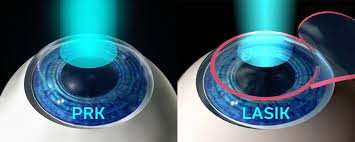How Laser Technology is Revolutionizing Eyecare
It amazes me how many types of lasers there are and how many different ways they can be used in eyecare. From correcting eyesight to treating diseases that were previously untreatable, lasers are offering new hope and improved quality of life for patients around the world. With the use of lasers, we can provide better visual outcomes by more accurately diagnosing diseases and providing safer treatment options. Here we will delve into some examples of laser use in eyecare, exploring their benefits and impacts on the way we treat our patients.
Did you know that LASER actually stands for Light Amplification by Stimulated Emissions of Radiation?
Lasers for correcting prescription
Most of you would think of this first when we talk about laser use in eyecare. There are two types of laser vision correction: LASIK and PRK. In LASIK a flap is cut on the cornea (which can be done with another type of laser or with a knife called a microkeratome) then a laser is used to reshape the cornea to correct myopia (nearsightedness), hyperopia (farsightedness), or astigmatism. With PRK, only a laser is used to reshape the cornea with no flap creation. PRK will take a little longer to recover but over the long term tends to have less complications such as dry eyes, the flap moving out of position, or the cornea getting too thin.
Lasers for glaucoma treatment
We treat glaucoma by lowering eye pressure. One way to do this is by opening up the drainage system of the eye by performing a laser trabeculoplasty or a selective laser trabeculoplasty (SLT). These produces can be done as a first line treatment to avoid having to put in pressure lowering eye drops every day, which have their own sets of side effects, most notably dry irritated eyes.
Lasers to assist with cataract surgery
Traditional cataract surgery would use a knife to make the first incision into the cornea but in laser assisted cataract surgery a femtosecond laser is used to make the incision and also used to help break up the cataract-damaged lens for easier removal. This level of precision enhances safety, improves outcomes, and may reduce the risk of complications compared to traditional methods.
Lasers to repair and treat the retina
Conditions such as diabetic retinopathy, retinal tears, and macular degeneration use lasers to destroy abnormal retinal tissue, seal leakages, or activate light-sensitive medications. Laser photocoagulation shrinks or destroys abnormal tissue causing scarring and pan-retinal photocoagulation (PRP) treats patients who have had abnormal blood vessel growth.
Why are lasers great for eyecare?
Precision: Lasers offer unparalleled precision, allowing for highly accurate surgical procedures and targeted treatments with minimal damage to surrounding tissue.
Safety: Laser procedures are often less invasive than traditional surgical methods, resulting in reduced risk of complications, shorter recovery times, and improved safety profiles.
Customization: Laser systems can be customized to suit each patient's unique anatomy and visual needs, maximizing treatment outcomes and patient satisfaction.
Efficacy: Laser treatments have demonstrated high success rates in correcting vision problems, managing eye conditions, and preserving or improving visual function.
As technology continues to advance, so too will the capabilities of laser technology in eye care. From enhancing vision to preserving ocular health, lasers have become an amazing tool in the arsenal of ophthalmologists worldwide. With ongoing research and innovation, the future holds even greater promise for leveraging laser technology to address a broader range of eye conditions and improve the lives of millions affected by visual impairment. At View Optometry, we can determine if any of the procedures discussed are needed for you to see you best!


